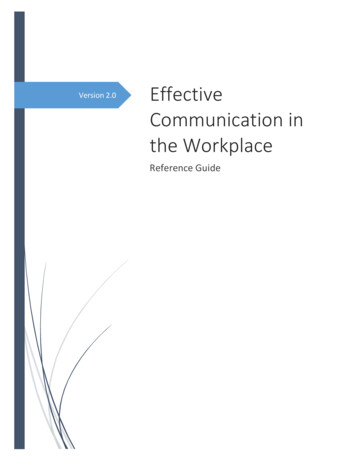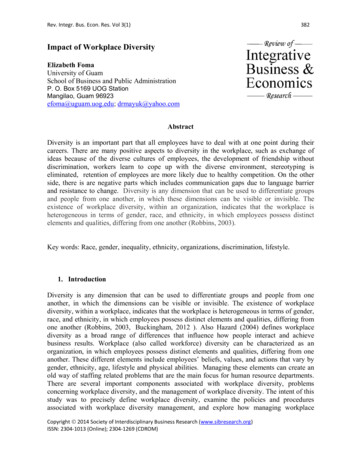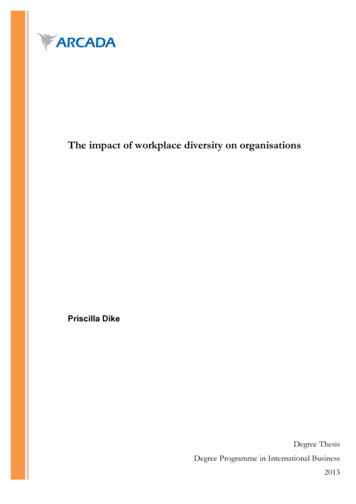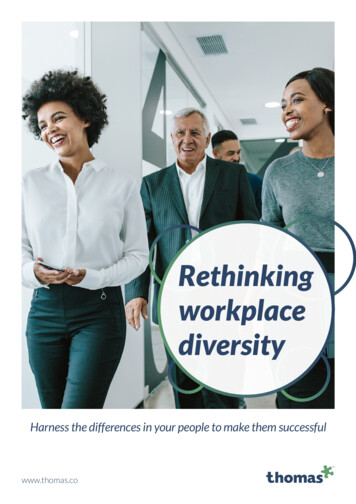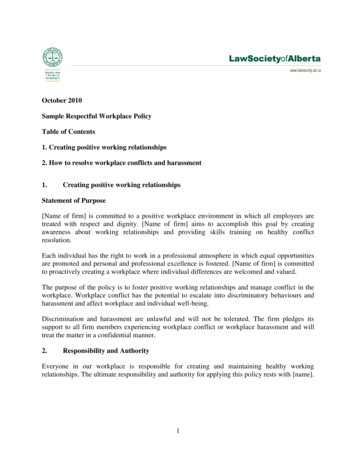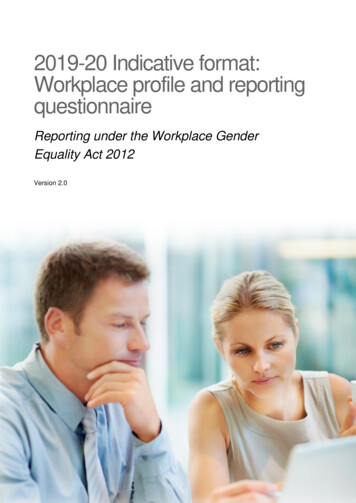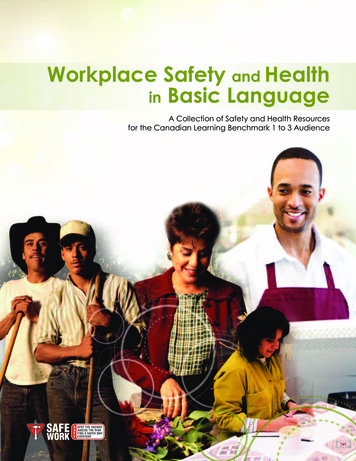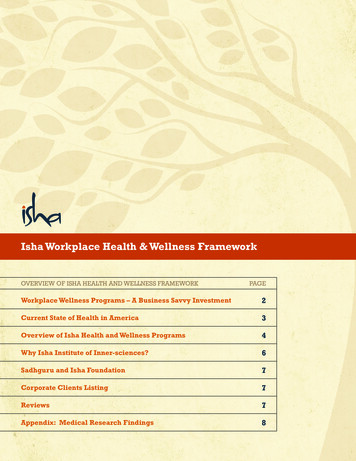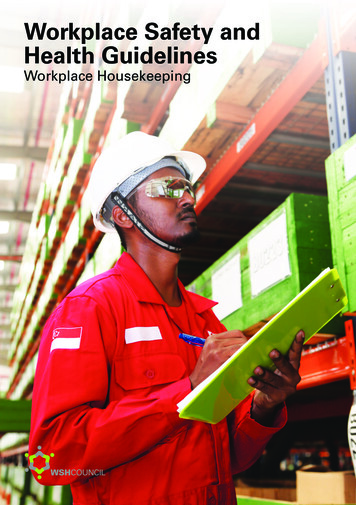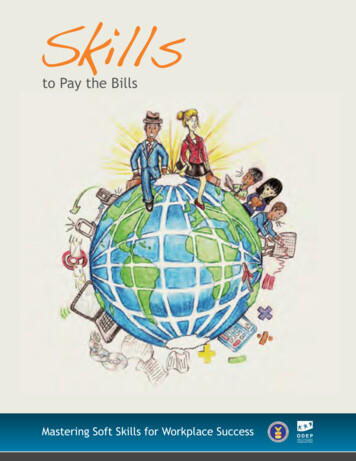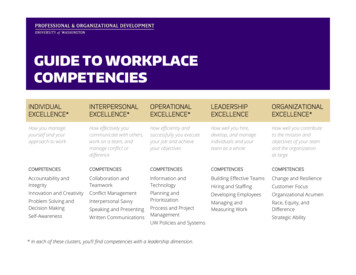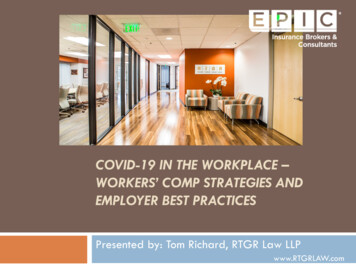
Transcription
COVID-19 IN THE WORKPLACE –WORKERS’ COMP STRATEGIES ANDEMPLOYER BEST PRACTICESPresented by: Tom Richard, RTGR Law LLPwww.RTGRLAW.com
The WC Law Firm for EmployersTom Richard, Founding Partnertom@rtgrlaw.com WCAB appeals, procedures andtactics. Complex WC claims andcontroversies. Fraud prevention andprosecution. Disability Accommodations andthe Interactive Process. Excess WC insurance claims andcoverage issues and disputes. 132a and Serious & WillfulMisconduct (S&W) defenses. Civil Subrogation recovery.
Questions, PDF of this PowerPoint Questions? Would you like a PDF copy of theprogram? E-mail your nearest RTGR Law office: OaklandLos AngelesSacramentoSan JoseOrange CountyVan NuysSan Diego News & Updates: website or follow us on LinkedIn. m
Disclaimer Theinformation contained in this presentation isprovided by RTGR Law LLP for educational andinformational purposes only. It is an abbreviatedoverview and should not be construed as legaladvice on any subject matter, nor as a substitute forlegal services. Copyright 2021 RTGR Law LLP (All Rights Reserved) Questions? rtgrlaw.com/contact/
COVID Claims Data The 8 states, including California, with rebuttablepresumptions for COVID-19 claims tended to havehigher COVID-19 claims rates than states withoutpresumptions.51% of all California Workers’ Comp claims inDecember 2020 were for COVID-19, up from29% in November.Denial rates for COVID-19 claims increased from33.1% in September to a seven-month high of37.9% in October.
What’s Coming in California? Lots ofCOVID Workers’ Comp Claims
COVID Claims QuestionsCan California’s “rebuttable” presumption forCOVID-19 claims actually be rebutted? How? How does the presumption law fit with thenotice law and OSHA regulations? Will COVID-19 claims continue to spike in2021? Are 30% denial rates for COVID-19 claimsappropriate? Should it be twice that? Or closerto 100%?
What else is coming: COVID-19Vaccines for Employees
Can an Employer Mandate COVID-19Vaccines?In May 2020, the Equal EmploymentOpportunity Commission (EEOC) issued astatement affirming employers’ right tomandate a vaccine when it becameavailable. In December, the EEOC confirmed that avaccination requirement on its own would notviolate the Americans with Disabilities Act(ADA).
Can an Employer Mandate COVID-19Vaccines? “At-will” employers can set employmentconditions around health and safety,generally speaking. Doesyour MOU or company policy limitthat? There are limits, however, includingreligious liberty and anti-disabilitydiscrimination rules.
Can an Employer Mandate COVID-19Vaccines? What steps can an employer take if anemployee cannot or will not be vaccinated? Theemployer must engage in the interactiveprocess of an individualized assessment todetermine whether an accommodation can bereached. If there is no way to provide a reasonableaccommodation without undue hardship thatwould eliminate or reduce the direct threat,the employer most likely can exclude thatemployee from the workplace.
What about adverse side-effects toCOVID-19 Vaccines? Short answer: an adverse/allergic reaction to theCOVID-19 vaccination given to employees willlikely be compensable under Workers’ Comp, if: Mandatedby the employer and injected anywhere,either at work or at an off-site location, even while offduty; or Not mandated but optionally offered at the workplace,especially in a medical or safety setting where theemployer clearly benefits from that inoculation.
Adverse side-effects example Example: Saint Agnes Medical Center v. WCAB(Cook) (1998) 63 CCC 220 (writ denied), an injurycaused by the adverse side-effects of a flu shot wasfound compensable, where it was optionally offeredby the medical center on-site, in part for the benefitof the employer, i.e., to help prevent the spread ofthe flu virus in the workplace to other employeesand to patients.
What about Vaccine paid-leave? Short answer: an adverse/allergic reaction to theCOVID-19 vaccination while off-duty, off-site maystill be compensable under Workers’ Comp, if: Employeeis paid regular salary or wage to go getvaccinated, even if that inoculation is optional. What if the employee is provided paid-leave, such asan allowance to use sick-leave or special “COVIDvaccine leave” by the employer?Answer: Maybe yes, maybe no. The closer you get to “mandatory,” “on-site” or “paid,” themore likely its covered by Workers’ Comp.
Agenda COVID-19 claims data COVID-19 vaccinations SB 1159 Presumption laws – overviewCan we/should we Deny COVID claims? Evenpresumptive injury claims?CalOSHA Regulations – to the rescue!685 Notice requirements – some claritySB 1159, OSHA Regs & AB 685 OverlapEmployer Liability and Special Employment IssuesFAQs
COVID-19 Presumption Laws
Presumption Laws Nationally Some 21 states have adopted COVIDpresumptions through legislative actions, governors'orders or agency rules. The scope of thepresumptions varies widely, as do claim denialrates.No state has linked Workers’ Comp claims to OSHAsafety violations, although a few, such as Californiaand Illinois, allow the inverse: Rebuttal of virusclaims if the company or agency followed diseaseprevention protocols.
California’s Presumption Law: SB 1159SB 1159, became law on September 17,2020. It adds three sections to the LaborCode: 3212.86, 3212.87, and 3212.88. Each section enacts a separate presumptionlaw, applying to different classes of employeesin different contexts.
Sec. 3212.86 of SB 1159 Sec. 3212.86 of SB 1159 mostly codifies ExecutiveOrder N-62-20 issued by the Governor on May 6,2020, which created a rebuttable presumption ofillness or death resulting from COVID-19 from March19, 2020 through July 5, 2020.
Sec. 3212.87 of SB 1159Sec. 3212.87 of SB 1159 creates apresumption of injury applicable to peaceofficers, firefighters and certain health careworkers, including some home-healthworkers. Sec. 3212.87 and Sec. 3212.88 pick up whereSec. 3212.86 leaves off, and are limited toinjuries occurring on or after July 6, 2020.
Sec. 3212.88 of SB 1159 Sec. 3212.88 covers all California employerswho have 5 or more employees. Thepresumption applies, if: An employee tests positive within 14 daysof a workday, and That positive test occurs when there was an“outbreak” of COVID-19 at the employee’sspecific place of employment.
Employer obligations under 3212.88 Starting Sept. 17, 2020, every time an employerknows or reasonably should know that an employeehas tested positive for COVID-19, the employermust report specified information to their Workers’Comp claims administrator.If the employer forgets to timely submit this data ormakes any clerical error in this reporting, it couldresult in a 10,000 penalty against theemployer for each violation.
Employee Tracking As part of this process, employers must accuratelytrack the number of their employees working ateach specific place of employment and timelyreport positive COVID-19 tests to their claimsadministrators.This is required whether or not a Workers’ Compclaim is made in connection with a specific test.
Notify claims within 3 days Once an employer “knows or reasonably shouldknow” that an employee has tested positive, theemployer is required to do the following: Sendwritten notification to its claims administratorwithin 3 business days of suspecting that anemployee has tested positive. The written notification “shall not provide anypersonally identifiable information regarding theemployee who tested positive for COVID19” unless the employee “asserts” the infection is workrelated, or has filed a claim form.
The test date After July 5, 2020, diagnosis alone does nottrigger the presumption: there must be apositive COVID-19 test within 14 days of work.Sec. 3212.88(i)(2), defines the positive testdate as: “The date the specimen wascollected for testing.”
Employer’s ongoing reporting The employer’s written reporting to the claimsadministrator must include data regarding the: Specificaddress or addresses of the employee’sspecific place(s) of employment during the 14-dayperiod preceding the date of the employee’s positivetest, as well as The highest number of employees who reported towork at each job site(s) in the 45-day period precedingthe last day the employee worked there. We interpretthis to mean the total number of employees.
What is a “specific place ofemployment”? The building, store, facility, or agricultural fieldwhere an employee performs work at theemployer’s direction. If the employee works atmultiple locations, then the presumption wouldapply if an “outbreak” exists at any one of thoselocations.Further, the employee’s positive test shall becounted for the purpose of determining theexistence of an outbreak at all of those places ofemployment.
What is a “specific place ofemployment”? “A specific place of employment” does not includethe employee’s home or residence, unless theemployee provides home health care services toanother individual at the employee’s home orresidence.It does not apply to buildings or other locations ofthe employer that the employee did not enter.
What happens with this data?With this information the claims adjuster is thentasked with the job of determining, on a rollingand continuous basis, whether an “outbreak”has occurred. An “outbreak” exists if within 14 calendardays one of the following occurs at a specificplace of employment
Claims Adjuster’s review of the data The claims administrator must use the informationto determine if an “outbreak” has occurred for thepurpose of applying the presumption. The adjustormust review every positive test and determine if therewere 4 or more, or 4% or more, within 14 days.If the adjuster concludes that an “outbreak” hasoccurred, then the presumption would apply. Theclaims administrator must continually evaluate eachclaim to determine whether the requisite number ofpositive tests have occurred during the surrounding14-day periods.
“Outbreak” defined A specific place of employment isordered to close by: alocal public health department, the State Department of Public Health, the Division of Occupational Safety andHealth, or a school superintendent due to a risk ofinfection with COVID-19.
“Outbreak” definedThe employer has 100 employees or fewer ata specific place of employment and four (4)employees test positive for COVID-19, or The employer has more than 100 employees ata specific place of employment and four (4)percent of the number of employees whoreported to the specific place of employment,test positive for COVID-19, or
Sick leave offset Where an employer has paid sick leave benefitsspecifically available in response to COVID-19,those benefits shall be used and exhausted beforeany TD or Labor Code section 4850 pay is due andpayable.Where an employee does not have such sick leavebenefits, the employee shall be provided TD orLabor Code section 4850 benefits from the date ofdisability. In other words, the “3-day waitingperiod” does not apply.
Can one Deny a COVID Claim?
Case Law to Consider LaTourette v. WCAB (1998) 63 CCC 253 andJohnson v. IAC (1958) 23 CCC 54 TheCalifornia Supreme Court has stated that the factthat “an employee contracts a disease while employedor becomes disabled from the natural progression of anonindustrial disease during employment will notestablish a causal connection ” Additionally, an ailment “does not become anoccupational disease simply because it is contracted onthe employer’s premises.”
In California, most jobs that are “highrisk” are covered by a presumption The types of jobs that may pose a materially greaterrisk of contracting COVID-19 (healthcare, publicsafety, etc.) under by OSHA’s COVID-19 HazardRecognition page, are now covered by a presumption.
Non-presumptive Lower Risk Claimants who are not covered by a presumption inCalifornia are likely in Medium to Low Risk jobs.That means, absent a presumption, if “an employeecontracts” COVID-19 “while employed duringemployment,” that alone “will not establish a causalconnection ”Absent extraordinary circumstances in a particularworkplace, its anyone's guess where and when theemployee contracted the disease.
Non-presumptive COVID claims denial Absent a presumption, it is the claimant’s burden ofproof by reasonable medical probability to showthat the disease was transmitted to them whileworking their medium to low risk job, as opposed toany social or off-work occasions.In short, if a presumption does not apply, the claimprobably can and should be denied, because therisks of contracting COVID-19 are risks ofcommonalty to the whole population.
What if a presumption applies? A legal presumption shifts the burden of proof to theemployer, to show that the disease was nottransmitted to the employee while working, and wasinstead more likely contracted in a social or off-worksetting.In short, if a presumption does apply, the claimprobably should be accepted in the employer doesnothing to meet that burden of proof.However, there is a formula meeting that burden ofproof in most cases.
The Presumptions are Rebuttable“Outbreak” Presumption: Sec. 3212.88(e)(2)specifically identifies “measures in place toreduce potential transmission of COVID-19” asrelevant evidence to rebut the presumption. “Healthcare/Public Safety” Presumption: Sec.3212.87(e) also says the presumption isrebuttable, though it does not mention remedialmeasures specially.
Presumption claim denial criteria If a presumption does apply, the presumption can stillbe rebutted and the claim can still be denied if theemployer had good remedial measures in place atthe time of the alleged exposure, and: There is a known contemporaneous non-workexposure (housemate or family member with COVID,known unsafe social interactions or travel, etc.), or There was insufficient “exposure” at work to a coworker/customer known to have COVID, within 6 feetfor 15 minutes or more in a 24 hour period.
“Remedial measures”? “Exposure”?
“Remedial measures” under Cal/OSHAEmergency Regs – (Pg. 1) Draft & implement a COVID-19Prevention Program; Thisis similar to the Injury and Illness PreventionProgram already required by state law. It must include a system for communicatingabout COVID-19 with employees. CalOSHA’s Model COVID-19 PreventionProgram:www.dir.ca.gov/dosh/dosh publications/CPP.doc
“Remedial measures” under Cal/OSHAEmergency Regs – (Pg. 2)Provide employee training on the COVID19 Prevention Program; Identify COVID-19 hazards withemployee input and correct them; Investigate COVID-19 cases; Within 1-business day, notify and providetesting to potentially exposed employees;
“Remedial measures” under Cal/OSHAEmergency Regs – (Pg. 3)Require physical distancing and mask wearing; Improve ventilation and maximize outdoor air; Quarantine infected employees away fromworkplace and pay them; If there is an “outbreak,” report it to the localpublic health department and providecontinuous testing to employees; Follow specified rules for employer-providedhousing and transportation.
Exceptions to Cal/OSHA COVID-19Emergency RegulationsDoes not apply to employees working fromhome exclusively; Does not apply to businesses covered byCalifornia’s Aerosol Transmissible Disease(ATD) standards (mostly health care facilitiesand emergency responders); Has recordkeeping and reporting obligationsin addition to and overlapping with thoseunder SB 1159 & AB 685.
Cal/OSHA Emergency Regs - ResourcesDIR’s Regulations FAQ 19FAQs.htmlCalOSHA’s 1-page summary for Employers:https://www.dir.ca.gov/dosh/dosh publications/COVIDOnePageFS.pdfCalOSHA’ Model COVID-19 Prevention Program:https://www.dir.ca.gov/dosh/dosh publications/CPP.doc
“Remedial measures” & Workers’ CompDid the employer have these measures inplace at the time of the alleged injury,and can we prove it? There may already be sufficient proof viathe recordkeeping and reportingobligations required by the OSHA Regs.,in addition to those under SB 1159 & AB685.
COVID-19 “exposure” defined “COVID-19 exposure” means: beingwithin six feet of a “COVID-19 case”(i.e., positive-tested person), and for a cumulative total of 15 minutes orgreater in a 24-hour period within oroverlapping with the “high-risk exposureperiod” defined by Labor Code §3205. This definition applies regardless of the useof face coverings.
Is OSHA your friend? Yes!“Exposure” and “remedial measures” arenot defined in SB1159 or AB685. Therefore, OSHA’s definitions shouldapply to presumption rebuttals. It also helps to show that the employerhas not been cited by OSHA inspectorsfor COVID violations in the relevant“place of employment.”
Presumption claim recap If a presumption does apply, the presumption can stillbe rebutted and the claim can still be denied if theemployer was compliant with the OSHA Regs at thetime of the alleged exposure (i.e., “remedialmeasures” were in place), and: There is a known contemporaneous non-workexposure (housemate or family member with COVID,known unsafe social interactions or travel, etc.), or There was insufficient “exposure” at work to a coworker/customer known to have COVID, within 6 feetfor 15 minutes or more in a 24 hour period.
Denials: Limited time to act“Outbreak” Presumption claims must be deniedwithin 45 days of the date of injury, per Sec.3212.88(f). “Healthcare/Public Safety” Presumption mustbe denied within 30 days of the date of injury,per Sec. 3212.87(f). The usual 90-day time-frame does not apply ifthere is a presumption.
Agenda check-in COVID-19 claims data COVID-19 vaccinations SB 1159 Presumption laws – overview Can we/should we Deny COVID claims? Evenpresumptive injury claims? CalOSHA Regulations – to the rescue! AB 685 Notice requirements – some claritySB 1159, OSHA Regs & AB 685 OverlapEmployer Liability and Special Employment IssuesFAQs
AB 685: Effective 01/01/2021employer
Sec. 6409.6 Notice Requirements AB 685 enacts many new Statutes. One of themost important is Labor Code Section 6409.6.Within one business day of an employer learningany employee, and in some situations the employeeof a subcontracted entity, was “exposed” to a“qualifying individual” at the work location, theemployer must provide specific written notices andinformation to its employees, the subcontractor andto employee representatives (definition notspecified).
Is Cal OSHA your friend, again?Labor Code Section 6409.6 applies whensomeone have been “exposed” to a“qualifying individual” at the work location. “Exposure” is not defined in AB685. OSHA’s definition (within 6 feet, 15 minutesto a positive person) could possibly limit thescope of those who must be noticed under AB685, just they help define rebuttal criteriaunder SB 1159.
Qualifying Individual (QI) Defined Any person (employee, subcontractor, student,patient, client, customer, visitor, etc.) who: Hasa laboratory-confirmed case of COVID-19; Is diagnosed with COVID-19 by a licensed health careprovider; Is under a COVID-19-related order to isolate providedby a public health official; or Has died due to COVID-19 as determined by thecounty public health department.
What Is Notice To The Employer?A public health official or licensed medicalprovider notifies the employer; An employee (or emergency contact) notifiesthe employer that the employee is a QI; The employer’s testing protocol (if any) revealsthat the employee is a QI; or A subcontracted employer notifies theemployer that a QI was on the worksite of theemployer.
What Information To Provide Information regarding COVID-19-related benefits as well asthe organization's anti-retaliation and anti-discrimina
Van Nuys. van@rtgrlaw.com . WCAB (Cook) (1998) 63 CCC 220 (writ denied), an injury caused by the adverse side -effects of a flu shot was found compensable, where it was . optionally. offered by the medical center on-site, in part for the ben

